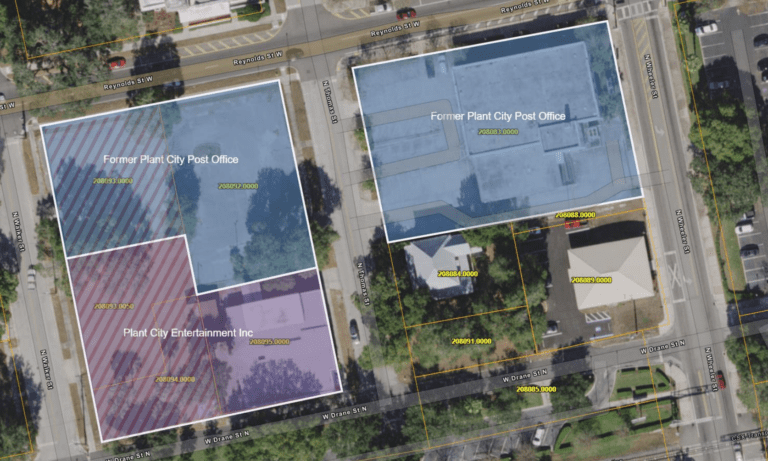
Three vacant parcels were removed from the Downtown Plant City Residential historic district boundary Monday evening after commissioners unanimously agreed to shift the border.
The City of Plant City agreed to redefine the Downtown Plant City Residential historic district boundary by removing three vacant parcels during Monday evening’s commission meeting.
If you’ve ever driven by the old post office on Reynolds Street or gone to a show at Plant City Entertainment you’ve more than likely noticed the empty lots adjacent to the two properties.
They have long been deemed a part of the Downtown Plant City Residential historic district boundary despite the fact that the lots the respective buildings are on are not a part of that historic residential district
The parcels in question are located east of North Walker Street, south of West Reynolds Street, and north of Northwest Drane Street.
The three parcels are owned by the City of Plant City and Plant City Entertainment Inc., respectively, and both parties were in favor of the removal of the boundary from the parcels, according to the City of Plant City. Essentially if commissioners agreed to remove the parcels from the historic district boundary it would “allow the commercial parcels to be seamlessly planned by the same set of standards and encourage an environment conducive for development.”
“What they are doing with this decision is that they’re saying there is a commercial operation and its sitting next to parcel that the same organization owns that was labeled residential historic,” City Manager Bill McDaniel said. “So you’re taking out those parcels and making them congruent with the adjacent commercial operations.”
While the Historic Resources Board was torn over whether or not the decision was the right one to make for Plant City — hence a 3-2 vote from the Board on April 20 — the commissioners seemed to have no qualms about unifying the parcels under one cohesive boundary.
In fact, the Historic Resources Board voted 3-2 to recommend that the city commission designate 301 W. Reynolds St., aka the former post office, as a local landmark.
During the presentation however, it was said that staff considered that recommendation to be “inconsistent with the action to redefine the historic district boundaries and recommends not to designate 301 W. Reynolds Street as a local landmark.”
Commissioners unanimously approved the amendment to the boundaries of the Downtown Plant City Residential historic district and did not act on making the former post office a local landmark.
It should be noted that the post office has had a complicated journey with the city. Back in 2018 the city commission voted to approve the purchase of the former post office building, its parking lot and outlying parking lots for $315,000. The unique building was built in 1935 and renovated in 1961. There were grand plans of renovations that would lead to a future use as an annex of City Hall. Initial assessments of the building were optimistic.
They knew when purchasing that there were asbestos and mold in the building, but the early reports said it was “entirely manageable.”
The preliminary assessments showed that it was going to take approximately $2.5 million to $3 million to renovate the facility. In comparison, the assessments said if the city wanted to rebuild a similar building it would cost them between $6 million and $7 million.
Then they dug deeper and a plethora of issues rose to the surface. The initial assessment was wrong and McDaniel told the Observer in August 2020 that it would take up to $2 million just to get the former post office ready to begin renovations. Then the city would have to add renovation costs. McDaniel said he “really wanted to find a way to make it work,” but added that the decision to fight to keep the building “just doesn’t make financial sense.”
So the city decided it would demolish the building, assess the space, get a design and cost estimate and begin construction on a new facility.
What precisely would fill the space was and still is up in the air. The lot is right in the heart of downtown Plant City and vacant lots are in high demand right now as developers eye the evolving and growing downtown core for future businesses and residential housing.
McDaniel said the decision Monday doesn’t change the city’s designs for the property as the vote to remove the Downtown Plant City Residential historic district boundary simply, “enables any decision that (the city) wants to make.”
